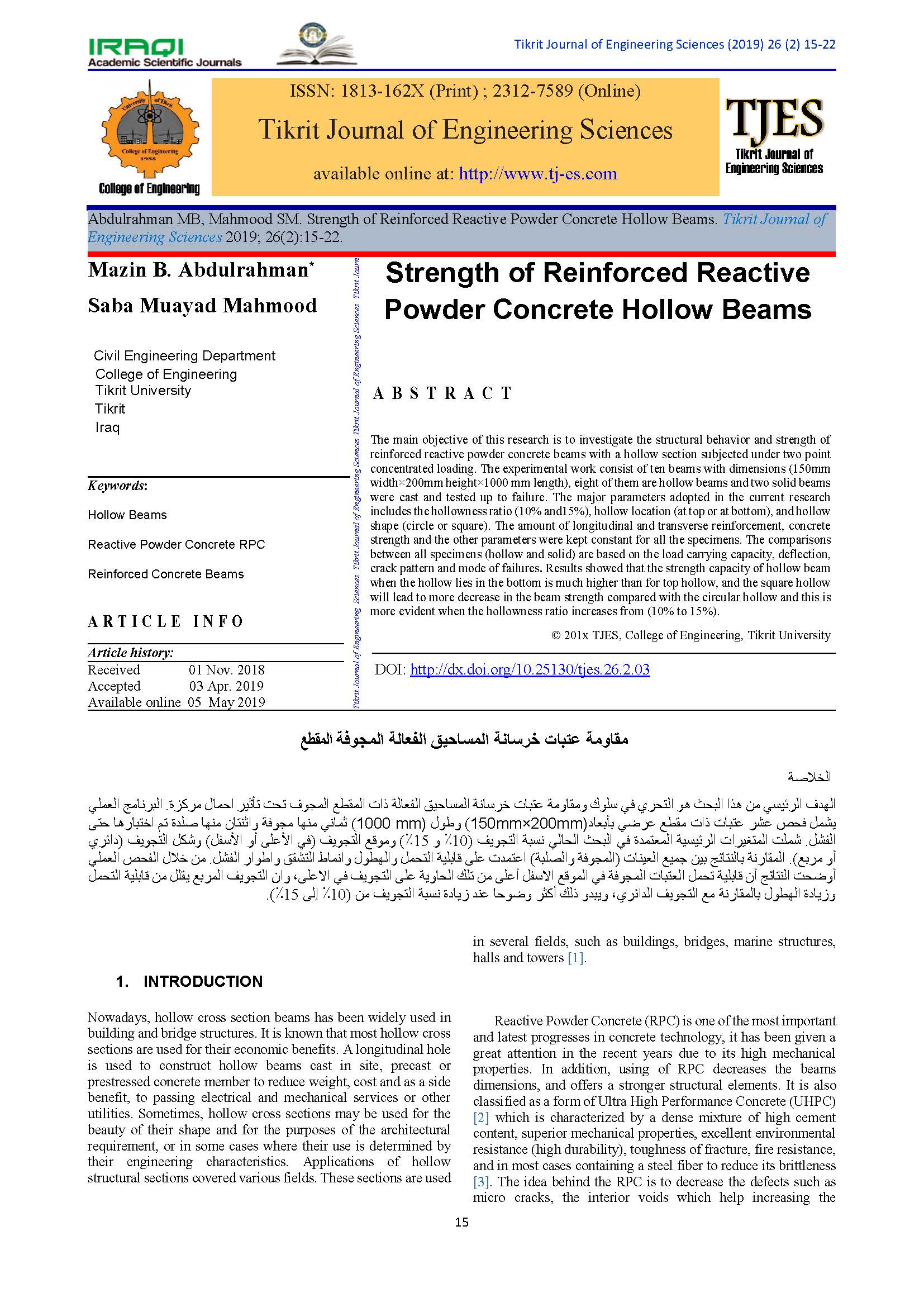Strength of Reinforced Reactive Powder Concrete Hollow Beams
Main Article Content
Abstract
The main objective of this research is to investigate the structural behavior and strength of reinforced reactive powder concrete beams with a hollow section subjected under two point concentrated loading. The experimental work consist of ten beams with dimensions (150mm width×200mm height×1000 mm length), eight of them are hollow beams and two solid beams were cast and tested up to failure. The major parameters adopted in the current research includes the hollowness ratio (10% and15%), hollow location (at top or at bottom), and hollow shape (circle or square). The amount of longitudinal and transverse reinforcement, concrete strength and the other parameters were kept constant for all the specimens. The comparisons between all specimens (hollow and solid) are based on the load carrying capacity, deflection, crack pattern and mode of failures. Results showed that the strength capacity of hollow beam when the hollow lies in the bottom is much higher than for top hollow, and the square hollow will lead to more decrease in the beam strength compared with the circular hollow and this is more evident when the hollowness ratio increases from (10% to 15%).
Article Details
Section

This work is licensed under a Creative Commons Attribution 4.0 International License.
THIS IS AN OPEN ACCESS ARTICLE UNDER THE CC BY LICENSE http://creativecommons.org/licenses/by/4.0/
References
Mouwainea EM. Experimental Study of Reinforced Concrete Hollow Beams under Torsion. M. Sc. Thesis, Civil Engineering, College of Engineering, Al-Mustansiriya University, (2014).
Hiremath P , Yaragal S C. Investigation on Mechanical Properties of Reactive Powder Concrete under Different Curing Regimes. Materials Today: Proceedings, (2017); 4(9), 9758-9762.
Sadrekarimi A. Development of a Light Weight Reactive Powder Concrete. Journal of Advanced Concrete Technology, Japan Concrete Institute, (2004); Vol.2, No.3, October, pp.409-417.
AL Saffar NS. Behavior of Ultra High Strength Reinforced Concrete Beams Under Monotonic and Repeated Loads. PhD. Thesis, University of Mosul, Iraq, (2018).
Joy J, Rajeev R. Effect of Reinforced Concrete Beam with Hollow Neutral Axis. IJSRD-International Journal for Scientific Research & Development, (2014); 2(10), 2321-0613.
Alshimmeri AJ, Al-Maliki HN. Structural Behavior of Reinforced Concrete Hollow Beams under Partial Uniformly Distributed Load. Journal of Engineering Volume (2014 ); 20, Number 7.
Manikandan, Dharmar, Robertravi. Experimental study on flexural 22ehavior of reinforced concrete hollow core sandwich beams. International Journal of Advance Research In Science And Engineering, IJARSE, (2015); Vol. No.4, Special Issue (01).
Ghadhban HN, Mushatt HA, Jaafar EK. Crack pattern and modes failure investigation of reinforced concrete inverted hollow core dapped end beam strengthened with longitudinal normal strand bars (bolts), Journal of Engineering and Sustainable Development, (January 2017); Vol. 21, No.01.
Iraqi Specification, No. 5/1984, Portland Cement.
B.S. 882. Specification for Aggregates from Natural Sources for Concrete. British Standards Institute, (1992 ).
ASTM C1240-03. Standard Specification for Use of Silica Fume as a Mineral Admixture in Hydraulic-Cement Concrete, Mortar, and Grout.
ASTM C494 / C494M – 17. Standard Specification for Chemical Admixtures for Concrete.
ASTM A615/A615M-09. Standard Specification for Deformed and Plain Carbon-Steel Bars for Concrete Reinforcement.
Al-Bayati ES. Behavior of Reactive Powder Reinforced Concrete Beams Exposed To Fire. PhD Thesis, University of Tikrit, Iraq, (2017).
ASTM C 109/C 109M-99. Standard Test Method for Compressive Strength of Hydraulic Cement Mortars.
Wille K, Naaman A E, Montesinos GJ. Ultra-High Performance Concrete with Compressive strength Exceeding 150 MPa (22 ksi): A simple Way. ACI Materials Journal, (2011);Vol. 108, No. 1, pp.46-54.
BS 1881, Part 116. Method for Determination of Compressive Strength of Concrete Cubes. British Standards Institution, (1989 ); pp. 3.
ASTM C 496/C496M -04. Standard Test Method For Splitting Tensile Strength Of Cylindrical Concrete Specimens,(2004).
ASTM C 293-02. Standard Test Method for Flexural Strength of Concrete (Using Simple Beam With Center-Point Loading), (2002); 3pp.





